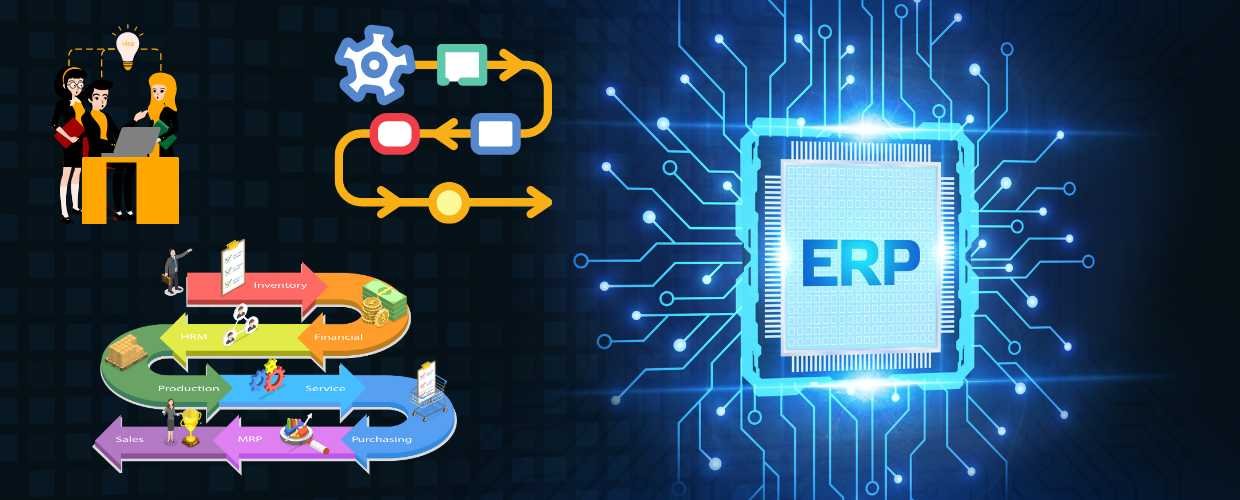In today’s intricate and rapidly evolving business landscape, characterized by complex interdependencies and dynamic market demands, Enterprise Resource Planning (ERP) systems have risen as indispensable tools for organizations seeking to optimize and manage their multifaceted operations. In this comprehensive exploration, we embark on a deep dive into the world of ERP, uncovering its core tenets, multifarious functionalities, undeniable advantages, pressing challenges, and its pivotal role in cultivating efficiency, cooperation, and strategic decision-making across diverse sectors and industries.
What is Enterprise Resource Planning (ERP)?
At its essence, Enterprise Resource Planning (ERP) represents a suite of integrated software applications that function as the beating heart of an organization’s operational ecosystem. Designed to harmonize and centralize diverse business processes, ERP systems transcend departmental boundaries, encompassing areas such as finance, human resources, manufacturing, supply chain, customer relationship management, and more. The goal of ERP systems is to facilitate the seamless flow of data and information across functions, fostering accuracy, efficiency, and collaboration.
Key Components of ERP Systems
ERP systems are multifaceted entities with several key components that collaborate harmoniously to craft a comprehensive solution for managing and optimizing organizational operations.
Core Modules
The core modules are at the foundation of ERP systems, representing the cornerstone of an organization’s operational infrastructure. These modules encompass a spectrum of functionalities, including finance, human resources, procurement, inventory management, and customer management. Core modules empower organizations to navigate complex challenges with agility and insight by offering a unified platform to manage critical operations and data.
Integration
Integration serves as the adhesive that binds the diverse components of ERP systems into a cohesive whole. Integration eradicates the traditional barriers of data silos and disjointed processes through seamless data exchange and real-time synchronization. By fostering a unified data ecosystem, integration ensures that all stakeholders have access to accurate and up-to-date information, thus enhancing collaboration and informed decision-making.
Reporting and Analytics
A cornerstone of ERP’s transformative power lies in its robust reporting and analytics capabilities. Organizations are equipped with advanced reporting tools that facilitate the extraction of insights from raw data, converting it into actionable intelligence. These tools empower decision-makers with customizable dashboards, visualizations, and reports, enabling them to monitor key performance indicators, identify emerging trends, and make informed choices that steer the organization toward success.
Workflow Automation
One of the most compelling aspects of ERP systems is their ability to automate workflows, thus driving efficiency and reducing the burden of manual tasks. Organizations can optimize routine and repetitive processes through sophisticated workflow automation mechanisms, thereby minimizing errors and accelerating task completion. This automation frees up valuable human resources and ensures that operations are carried out consistently and according to predefined standards.
Benefits of Enterprise Resource Planning (ERP)
The strategic implementation of ERP systems yields a multitude of benefits that extend beyond mere operational efficiency, encompassing collaboration, data-driven decision-making, and strategic alignment.
Streamlined Processes
In modern business operations’ labyrinth, ERP systems are the compass that guides organizations toward streamlined processes. By centralizing operations within a unified platform, ERP eradicates redundancies, eliminates duplicated efforts, and ensures that each facet of the organization functions in harmony. This streamlining is the bedrock upon which efficiency and accuracy are built.
Data Visibility
The adage “knowledge is power” aptly captures the essence of ERP’s data visibility capabilities. Organizations armed with ERP systems gain unprecedented access to real-time data spanning different functions and departments. This comprehensive visibility enables decision-makers to access accurate information when they need it most, transforming data into a strategic asset that fuels informed decision-making and swift responses to emerging challenges.
Enhanced Collaboration
ERP systems are the conduits through which collaboration blooms across organizational boundaries. ERP systems foster cross-functional collaboration and communication by providing a shared platform that houses comprehensive data and insights. Employees from diverse departments can access shared data, work on joint projects, and contribute their expertise to a collective effort, leading to improved synergy and holistic problem-solving.
Improved Customer Satisfaction
At the heart of any successful organization lies a commitment to superior customer experiences, and ERP systems play a pivotal role in achieving this. Through integrated customer relationship management functionalities, ERP systems empower organizations to understand their customers at a granular level. This understanding enables organizations to personalize interactions, tailor marketing efforts, and respond swiftly to customer inquiries, thus enhancing overall satisfaction and loyalty.
Strategic Decision-Making
The cornerstone of every thriving organization is strategic decision-making guided by data-driven insights. ERP systems position organizations at the forefront of this paradigm shift by providing decision-makers with accurate, real-time data and analytical tools. Armed with this arsenal, organizations can identify trends, anticipate market shifts, and devise strategies that capitalize on emerging opportunities, propelling the organization toward sustained growth.
Practical Applications of ERP
The versatility of ERP systems transcends industry boundaries, showcasing their adaptability to diverse sectors.
Manufacturing
In the dynamic realm of manufacturing, ERP systems orchestrate a symphony of efficiency and precision. Manufacturers can optimize production processes, monitor inventory levels in real-time, manage supply chain operations, and fine-tune resource allocation. The result is a harmonious assembly line that balances demand with supply, ensuring timely delivery of finished goods and optimal utilization of resources.
Retail
The retail sector embraces ERP systems to navigate the intricate dance between supply and demand. With real-time inventory tracking, retailers can ensure that products are available precisely when customers seek them. The integration of customer data empowers retailers to offer personalized shopping experiences, from tailored recommendations to targeted marketing campaigns, ultimately fostering customer loyalty and brand affinity.
Finance and Accounting
ERP systems act as the financial command center for organizations, offering a panoramic view of financial health and performance. By automating financial processes, tracking expenses, managing accounts payable and receivable, and generating comprehensive financial reports, organizations can uphold financial compliance, minimize errors, and make sound budgeting decisions that underpin sustained fiscal success.
Human Resources
Within the realm of human resources, ERP systems transform the employee experience. Organizations streamline HR operations by centralizing employee data, payroll processing, benefits administration, and performance management, facilitating accurate payroll processing, and driving employee engagement. The result is a workforce that is motivated, engaged, and poised for growth.
Supply Chain Management
ERP systems revolutionize supply chain management by providing organizations with real-time visibility into every supply chain link. From procurement and logistics to inventory management and distribution, organizations can optimize each step, predict demand fluctuations, and forge stronger relationships with suppliers. The result is an agile and responsive supply chain that precisely meets customer needs.
Challenges of ERP Implementation
The journey of ERP implementation, while yielding transformative outcomes, presents organizations with a set of challenges that demand strategic navigation and meticulous planning.
Complex Implementation Process
ERP implementation is a multifaceted endeavor that demands meticulous planning, execution, and comprehensive training. The integration of various functions and processes can be intricate and time-intensive, necessitating a dedicated commitment of resources and expertise.
Change Management
As organizations transition to ERP systems, change management becomes a pivotal consideration. Employees accustomed to traditional workflows may resist the change, underscoring the importance of robust change management strategies that foster acceptance, communication, and user adoption.
Data Migration and Integration
The migration of data from legacy systems and its seamless integration into the new ERP environment can be daunting. Organizations must ensure that data is accurately transferred, aligned, and compatible with the new system to prevent data inconsistencies and disruptions in operations.
Customization vs. Out-of-the-Box Solutions
Organizations are often faced with the decision of customizing the ERP system to suit their unique needs or adopting out-of-the-box solutions. Striking the right balance between customization and system stability is paramount, as excessive customization may lead to complexity and increased maintenance efforts.
Future Trends in ERP
The ever-evolving landscape of technology introduces new trends that redefine the trajectory of ERP systems, ensuring their continued relevance and adaptability.
Cloud-based ERP
Cloud-based ERP solutions emerge as a dominant trend, offering organizations the benefits of flexibility, scalability, and accessibility. These solutions enable remote access to ERP functionalities, making them especially pertinent in the context of remote work environments and geographically dispersed teams.
AI and Machine Learning Integration
The convergence of AI and machine learning with ERP systems heralds a new era of predictive and prescriptive analytics. By leveraging these technologies, organizations can forecast trends, automate routine tasks, and unearth insights that drive proactive decision-making and operational efficiency.
Enhanced Mobility
In an increasingly mobile world, ERP systems evolve to offer enhanced mobility. The advent of mobile apps and responsive interfaces enables users to access critical ERP functionalities from smartphones and tablets, empowering decision-makers to remain engaged and informed, even while on the move.
IoT Integration
The Internet of Things (IoT) injects real-time data into the veins of ERP systems. Integration with IoT devices facilitates real-time monitoring of equipment, assets, and processes. This capability enhances maintenance practices, optimizes operational efficiency, and propels organizations toward a new realm of agility.
Conclusion
In the tapestry of modern business strategies, Enterprise Resource Planning (ERP) systems stand as paragons of operational efficiency. By converging diverse functions and processes into a unified platform, ERP systems empower organizations to navigate complexity with clarity, seize opportunities with agility, and chart a course toward sustainable growth. While the journey of ERP implementation presents challenges, the rewards of streamlined processes, data-driven insights, and enhanced customer experiences underscore the imperative role of ERP in shaping modern business strategies.
As industries continue to evolve and technology advances, the future of ERP holds the promise of deeper integration, heightened intelligence, and unwavering mobility. With ERP at their helm, organizations are poised to achieve unprecedented levels of operational excellence, strategic alignment, and enduring growth.










